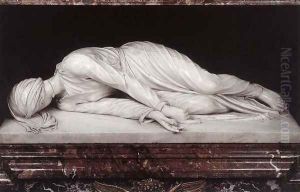Stefano Maderno Paintings
Stefano Maderno was an Italian sculptor of the early Baroque period, born in 1576 in Bissone, a territory of the Swiss canton of Ticino but then part of the Duchy of Milan. Despite the scarcity of documented details about his personal life, Maderno's work has left a significant mark on the history of art, particularly in Rome where he spent most of his career. His style reflects a transition from the classical Renaissance to the more dynamic and emotional expressions of Baroque sculpture, embodying a naturalistic approach that was innovative for his time.
Maderno is best known for his masterpiece, the sculpture of Saint Cecilia in the Church of Santa Cecilia in Trastevere, Rome, completed in 1600. According to legend, when the tomb of Saint Cecilia was opened in 1599, her body was found to be incorrupt, and Maderno was commissioned to create a sculpture capturing her just as she was seen at that moment. This work is celebrated for its remarkable lifelike detail and the delicate portrayal of the saint's form, which marked a significant departure from the Mannerist style prevalent in the late 16th century.
Besides his renowned sculpture of Saint Cecilia, Maderno worked on various projects, including contributions to the architectural designs of several Roman churches and palaces. His ability to infuse his sculptures with a sense of vitality and realism was highly praised by his contemporaries and has continued to be admired by generations of art historians and enthusiasts. Despite facing competition from other prominent artists of his time, Maderno's work retained a distinct place in Baroque art, characterized by its emotional depth and technical precision.
Maderno's influence extended beyond his lifetime, contributing to the evolution of Baroque sculpture. His approach to depicting human figures in a naturalistic yet dynamic manner paved the way for other sculptors of the Baroque period. Stefano Maderno passed away in 1636, leaving behind a legacy that significantly impacted the development of Italian art. His work remains a testament to the artistic transition that occurred during his lifetime, bridging the gap between the Renaissance and Baroque periods.
